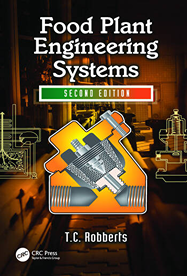Food Plant Engineering Systems
Material type: TextLanguage: English Publication details: Boca Raton, FL : CRC Press, 2016Edition: 2ndDescription: XXII, 333 p. : illISBN:
TextLanguage: English Publication details: Boca Raton, FL : CRC Press, 2016Edition: 2ndDescription: XXII, 333 p. : illISBN: - 9781138199392
- 664.00682 ROB
| Item type | Current library | Shelving location | Call number | Copy number | Status | Date due | Barcode |
|---|---|---|---|---|---|---|---|
 Reference Collection
Reference Collection
|
Seminar Library | Department of Food Engineering | 664.00682 ROB | 2022-23 | Available | 98081 | |
 Reference Collection
Reference Collection
|
Seminar Library | Department of Food Engineering | 664.00682 ROB | 2022-23 | Available | 98082 |
Biography
Theunis C. Robberts, Ph.D., is the program director for the manufacturing management majors at the University of Minnesota, where he received the Distinguished Faculty Award. He teaches principles of engineering, product development, quality systems, regulations and compliance, and business analytics. Dr. Robberts received his undergraduate qualification in food technology at Cape Technikon in South Africa and a Ph.D. in business administration, business quantitative methods, from Northcentral University in Prescott Valley, Arizona. His present research and outreach are focused on the establishment of business parks and light manufacturing facilities. Dr. Robberts received the Ernest Oppenheimer Memorial Trust Award for senior researchers. He has published articles and presented lectures at several scientific meetings, including the Institute of Food Technologists (IFT). He is a member of American Society for Quality (ASQ).
SUMMARY:
The component parts of a manufacturing system are important. Without peripherals and services such as pumps, boilers, power transmission, water treatment, waste disposal, and efficient lighting, the system will collapse. Food Plant Engineering Systems, Second Edition fills the need for a reference dealing with the bits and pieces that keep systems running, and also with how the peripheral parts of a processing plant fit within the bigger picture.
The author has gathered information from diverse sources to introduce readers to the ancillary equipment used in processing industries, including production line components and environmental control systems. He explores the buildings and facilities as well as the way various parts of a plant interact to increase plant production. This new edition covers the systems approach to Lean manufacturing, introducing Lean principles to the food industry. It also addresses sustainability and environmental issues, which were not covered in the first edition.
Written so readers with only basic mathematical knowledge will benefit from the content, the text describes measurements and numbers as well as general calculations, including mass and energy balances. It addresses the properties of fluids, pumps, and piping, and provides a brief discussion of thermodynamics. In addition, it explores electrical system motors, starters, heating, and lights; heating systems and steam generation; cooling and refrigeration systems; and water, waste, and material handling systems. The text also deals with plant design, including location, foundations, floors, walls, roofs, drains, and insulation. The final chapter presents an overview of safety and OSHA regulations, and the appendices provide conversion tables and an introduction to mathematics
